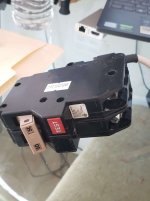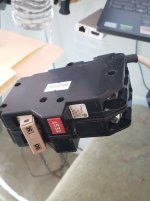Question to any that can help. The current breaker has a neutral white wire as well. See photo. It is a $200 breaker to replace. Can't i use a regular 40 or 50amp breaker? what purpose does the neutral back serve? All my 240v appliances do not have a white, example, oven.
Main Breaker Tripping But NOT GFCI
- Thread starter parkerma
- Start date
You are using an out of date browser. It may not display this or other websites correctly.
You should upgrade or use an alternative browser.
You should upgrade or use an alternative browser.
Hi dave, see my last post in this thread. It has a 50 amp 2 pole but with a neutral wire. Is this needed? To replace this breaker is $200A GFCI breaker is a regular breaker with added GFCI functionality.
If I am understanding this correctly, you have a normal breaker in your panel, that runs to a GFCI breaker in a sub panel and then to your hot tub. This is a dedicated circuit with nothing else on it.
You came home to a tripped breaker in your main panel.
You disconnected the hot tub (how, what do you mean by "disconnected") and the main breaker stayed on, as well as the GFCI breaker.
You reconnected the hot tub, and the main breaker immediately trips. Regardless of what is running or not, any load trips the main.
It does sound to me like there is a issue with the main breaker. They can go bad. If you are comfortable changing a breaker out, then you may want to try doing so. You are looking at about $50 for a new 50 amp two pole breaker
Attachments
RDspaguy
In The Industry
That is a gfci breaker, not a standard breaker, and should be in the disconnect not the main panel. You do not need 2.
If your disconnect breaker does not have the neutral, then it is a standard breaker.
All of the advice that you have been given is based on this.
That being a gfci breaker puts us back to square one on troubleshooting, as now it can be a ground fault causing it. Therefore, it is not a foregone conclusion that the breaker is bad.
Post pics of circuit board and equipment area.
If your disconnect breaker does not have the neutral, then it is a standard breaker.
All of the advice that you have been given is based on this.
But that is a gfci breaker, I assume from your main panel. Is there a gfci in the disconnect?you have a normal breaker in your panel, that runs to a GFCI breaker in a sub panel and then to your hot tub.
That being a gfci breaker puts us back to square one on troubleshooting, as now it can be a ground fault causing it. Therefore, it is not a foregone conclusion that the breaker is bad.
Post pics of circuit board and equipment area.
cranbiz
Well-known member
That's a GFCI breaker. If you are replacing a GFCI breaker, yes, you need the neutral pigtail. That looks like a Cutler Hammer BR series and if it is, Home Depot sells it for $130.
Which panel is that from?
Which panel is that from?
This is from the main panel and is a CH series.That's a GFCI breaker. If you are replacing a GFCI breaker, yes, you need the neutral pigtail. That looks like a Cutler Hammer BR series and if it is, Home Depot sells it for $130.
Which panel is that from?
Main breaker, and of course, HD out of themThat's a GFCI breaker. If you are replacing a GFCI breaker, yes, you need the neutral pigtail. That looks like a Cutler Hammer BR series and if it is, Home Depot sells it for $130.
Which panel is that from?
I do see a slight amount of visible moisture on the "inside" of the electronics housing. Could that be popping it?That is a gfci breaker, not a standard breaker, and should be in the disconnect not the main panel. You do not need 2.
If your disconnect breaker does not have the neutral, then it is a standard breaker.
All of the advice that you have been given is based on this.
But that is a gfci breaker, I assume from your main panel. Is there a gfci in the disconnect?
That being a gfci breaker puts us back to square one on troubleshooting, as now it can be a ground fault causing it. Therefore, it is not a foregone conclusion that the breaker is bad.
Post pics of circuit board and equipment area.
Attachments
-
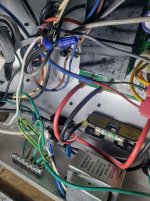 1667594341062.JPEG483.8 KB · Views: 11
1667594341062.JPEG483.8 KB · Views: 11 -
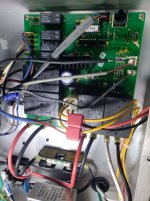 1667594339309.JPEG481.3 KB · Views: 11
1667594339309.JPEG481.3 KB · Views: 11 -
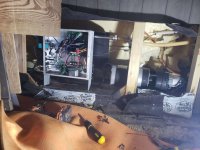 1667594337766.JPEG415.6 KB · Views: 11
1667594337766.JPEG415.6 KB · Views: 11 -
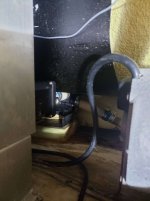 1667594335797.JPEG318.7 KB · Views: 10
1667594335797.JPEG318.7 KB · Views: 10 -
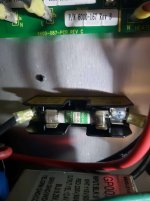 1667594334251.JPEG232.8 KB · Views: 8
1667594334251.JPEG232.8 KB · Views: 8 -
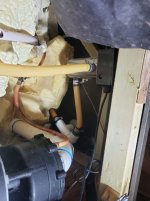 1667594331761.JPEG317.6 KB · Views: 8
1667594331761.JPEG317.6 KB · Views: 8 -
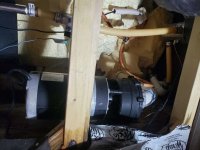 1667594330425.JPEG383 KB · Views: 8
1667594330425.JPEG383 KB · Views: 8 -
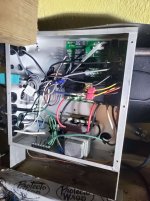 1667594330068.JPEG405.4 KB · Views: 7
1667594330068.JPEG405.4 KB · Views: 7 -
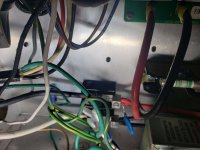 1667594342243.JPEG278.2 KB · Views: 10
1667594342243.JPEG278.2 KB · Views: 10
I put the breaker back in, disconnected the heater, it still popped. I disconnected the tub at the block on the circuit board, and the main breaker did not pop. So... pump, circuit board or topside controller? Again, i did see a little bit of moisture but not sure if that would pop it?I do see a slight amount of visible moisture on the "inside" of the electronics housing. Could that be popping it?
- Jul 21, 2013
- 65,127
- Pool Size
- 35000
- Surface
- Plaster
- Chlorine
- Salt Water Generator
- SWG Type
- Pentair Intellichlor IC-60
Can't i use a regular 40 or 50amp breaker?
That is a GFCI breaker and required by code for the spa.
what purpose does the neutral back serve?
The neutral pigtail that connects to the neutral bus is part of the GFCI mechanism. All GFCI CBs have the neutral pigtail.
If the neutral pigtail is not connected to the neutral bus the GFCI CB will not work.
All my 240v appliances do not have a white, example, oven.
None of those appliances require a GFCI CB.
I do see a slight amount of visible moisture on the "inside" of the electronics housing. Could that be popping it?
Well, i unplugged component by component. When i unplugged the circulation pump, it did not pop. So, i think it is safe to say it is the circulation pump and not the board or the main pump. Strange considering i just replaced the circulation pump about 18 months ago.That is a gfci breaker, not a standard breaker, and should be in the disconnect not the main panel. You do not need 2.
If your disconnect breaker does not have the neutral, then it is a standard breaker.
All of the advice that you have been given is based on this.
But that is a gfci breaker, I assume from your main panel. Is there a gfci in the disconnect?
That being a gfci breaker puts us back to square one on troubleshooting, as now it can be a ground fault causing it. Therefore, it is not a foregone conclusion that the breaker is bad.
Post pics of circuit board and equipment area.
RDspaguy
In The Industry
If you have water on the board you can't trust any test. Dry it off with a hair dryer on low heat. Find out where the water is coming from. Your circ pump, or jet pump or heater for that matter, could also be wet and causing a gfci trip (which would not trip a standard breaker). Dry out the equipment thoroughly before buying anything, from the looks of that board you've got something spraying under there and who knows what all is getting wet.
Check the breaker in the disconnect for a test button. If it has one it is a gfci and you can buy a standard breaker for the main panel. If it does not, you need a gfci in one or the other, I recommend in the disconnect. But don't buy one yet until you get everything dry under there.
Check the breaker in the disconnect for a test button. If it has one it is a gfci and you can buy a standard breaker for the main panel. If it does not, you need a gfci in one or the other, I recommend in the disconnect. But don't buy one yet until you get everything dry under there.
phonedave
Well-known member
- May 30, 2012
- 2,234
- Pool Size
- 17000
- Surface
- Vinyl
- Chlorine
- Salt Water Generator
- SWG Type
- Hayward Turbo Cell (T-CELL-5)
If you have water on the board you can't trust any test. Dry it off with a hair dryer on low heat. Find out where the water is coming from. Your circ pump, or jet pump or heater for that matter, could also be wet and causing a gfci trip (which would not trip a standard breaker). Dry out the equipment thoroughly before buying anything, from the looks of that board you've got something spraying under there and who knows what all is getting wet.
Check the breaker in the disconnect for a test button. If it has one it is a gfci and you can buy a standard breaker for the main panel. If it does not, you need a gfci in one or the other, I recommend in the disconnect. But don't buy one yet until you get everything dry under there.
Follow what @RDspaguy says.
You need one GFCI breaker in the circuit. It really does not matter where, but in most cases it ends up being in the disconnect. It is a quirk of pricing that it is normally cheaper to buy the disconnect with an included GFCI break than it is to buy a GFCI breaker on it's own (as you found out when you went to buy one)
The fact that you have a a GFCI breaker in your main negates all of the keyboard troubleshooting that went on here. Given this new information it does sound like something in the tub itself is leaking current.
As to why would the breaker in the panel trip first when the disconnect is "closer" to the fault (again, electricity does not work that way when it comes to "closer").
GFCI breakers are supposed to trip when the current difference is more than 5mA +/- 1mA. That means your breaker in the disconnect could be set to trip at 6mA and the one in the main panel at 4mA and both would still be within tolerances. It is common to say they trip at 5mA, but things have differences in manufacturing.
Methuselah
Well-known member
Agree with (all) the advice given by @RDspaguy, especially drying stuff out and diagnosing/stopping recurrence.We are dealing with an issue that arose this past winter and not addressing it until now.
Last January the heater in our tub went. It was the wiring that had corroded over time. We replaced the heater and everything was working perfectly. Please note we also recently within the past year replaced the circulation pump and flow switch. We left for a few months and came back to find that the breaker was tripped at the main panel. I inspected the GFCI, disconnected the tub and the main breaker stays on when flipped back on. I hooked the tub back up and turned the main breaker on but it would not stay on at all.
I have read that if you disconnect the components from GFCI and the breaker stays on, then it is the tub. But, wouldn't you expect the GFCI to pop as well if it was the tub since that is the first breaker in the line? It seems strange that the GFCI would not pop.
I am about to purchase a new circuit board, but want to be sure it is not the GFCI before moving forward.
However, that said, your original post plus thread suggests you have two GFCI's, one feeding the next? I'm not positive but I seem to recall it is not recommended to do this. I get foggy on this part and it may be manufacturer proprietary info, but a breaker may "test" periodically. Not sure what this would do to downstream balance especially if both entered this mode simultaneously?
Maybe I'm off base here (above). Still I believe you need a regular breaker and a GFCI, not two GFCI'S. Mostly though, as @RDspaguy said, you really need a dry control board and equipment cabinet. I suspect dampness can not only invite leakage, but make it dangerous.
Edit:
Will add, these GFCI breakers can and do go bad. If you remove one keep it as a spare for the other. Mine is lifetime warranty BTW...
Last edited:
RDspaguy
In The Industry
Exactly. It happens everywhere in the circuit simultaneously.As to why would the breaker in the panel trip first when the disconnect is "closer" to the fault (again, electricity does not work that way when it comes to "closer").
Making it a 20% tolerance, double that of most electrical devices. Allowing alot of difference between "identical" breakers.+/- 1mA.
It has a test button that you should manually check periodically. It does not automatically trip, and may or may not trip the other when tested (again, tolerances). It does not self-test.a breaker may "test" periodically.
Gfci's are specifically designed to trip at amperages that are safe for humans. Their sole purpose is to save lives, and they are effective at that. A PITA in other ways perhaps, but definitely good at stopping electrocution.I suspect dampness can not only invite leakage, but make it dangerous.
phonedave
Well-known member
- May 30, 2012
- 2,234
- Pool Size
- 17000
- Surface
- Vinyl
- Chlorine
- Salt Water Generator
- SWG Type
- Hayward Turbo Cell (T-CELL-5)
Agree with (all) the advice given by @RDspaguy, especially drying stuff out and diagnosing/stopping recurrence.
However, that said, your original post plus thread suggests you have two GFCI's, one feeding the next? I'm not positive but I seem to recall it is not recommended to do this. I get foggy on this part and it may be manufacturer proprietary info, but a breaker may "test" periodically. Not sure what this would do to downstream balance especially if both entered this mode simultaneously?
Maybe I'm off base here (above). Still I believe you need a regular breaker and a GFCI, not two GFCI'S. Mostly though, as @RDspaguy said, you really need a dry control board and equipment cabinet. I suspect dampness can not only invite leakage, but make it dangerous.
GFCI breakers (or receptacles for that matter) do not test on their own, you are supposed to test them by pushing the test button monthly - but hardly anybody does.
There is nothing unsafe about attaching a GFCI to a GFCI. There is nothing better about it either. It does not make things any safer.
It can make troubleshooting a PITA. In the case of a breaker running to a breaker to a single device, it is not a big issue. But when you have a GFCI receptacle feeding another GFCI, and one trips, it may (or may not) trip the other. And then if both trip, you have to reset the device that is first in line first, because the other one will not reset without power, but if you don't know you have an other daisy chained to it, then you think you have a dead GFCI until you pull it from the wall, and then you are like "why do I have no power here" and then you go looking around the house for an other GFCI and find out that it is actually a light above a tub but it is being fed from a blank GFCI panel in a linen closet (not like I would know anything about that)
- Jul 21, 2013
- 65,127
- Pool Size
- 35000
- Surface
- Plaster
- Chlorine
- Salt Water Generator
- SWG Type
- Pentair Intellichlor IC-60
However, that said, your original post plus thread suggests you have two GFCI's, one feeding the next? I'm not positive but I seem to recall it is not recommended to do this. I get foggy on this part and it may be manufacturer proprietary info, but a breaker may "test" periodically. Not sure what this would do to downstream balance especially if both entered this mode simultaneously?
Maybe I'm off base here (above).
Yup, two GFCI breakers in series is not recommended and unnecessary but works just fine.
"Downstram balance" is not an issue.
Update, replaced the circulation pump and all is working well now! Thank you for all the feedback and comments.Well, i unplugged component by component. When i unplugged the circulation pump, it did not pop. So, i think it is safe to say it is the circulation pump and not the board or the main pump. Strange considering i just replaced the circulation pump about 18 months ago.
GFCI breakers (or receptacles for that matter) do not test on their own
- Includes self-test as required by UL 943 as an added safety feature.
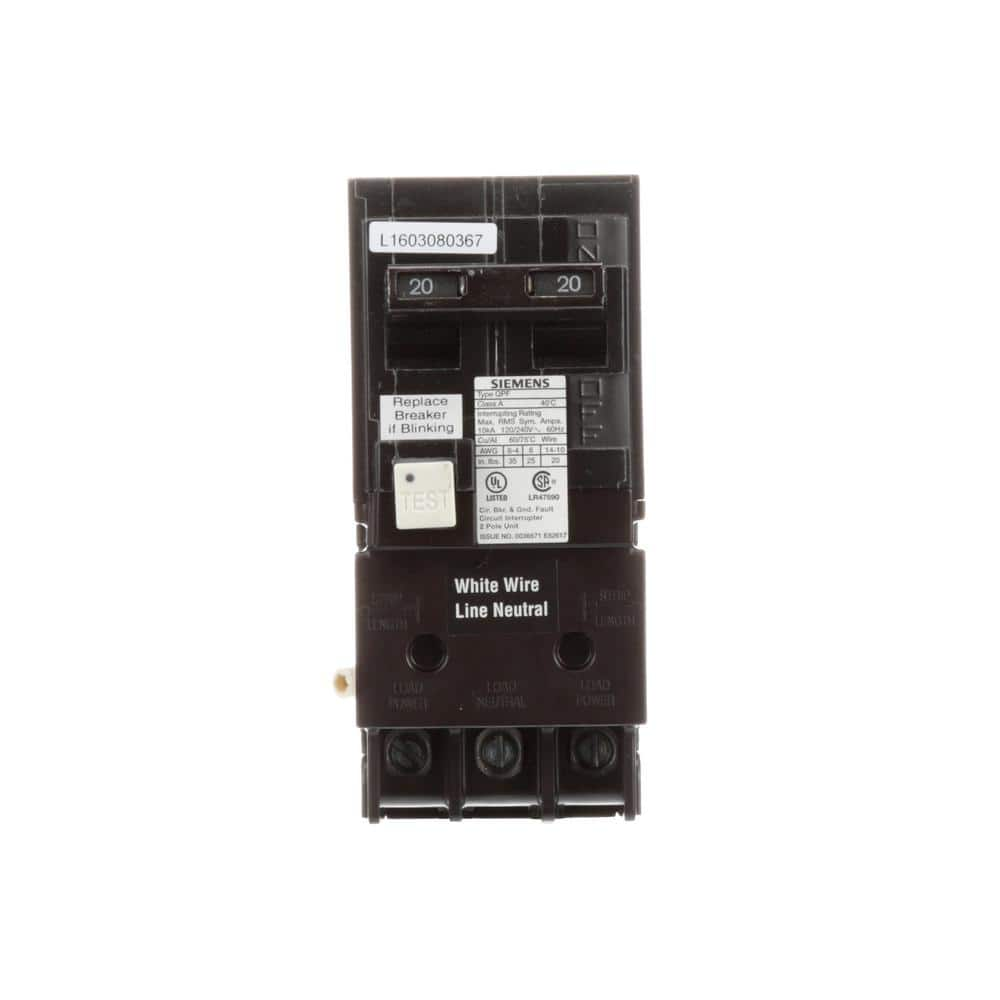
Siemens 20 Amp Double Pole Type QPF2 GFCI Circuit Breaker US2:QF220AP - The Home Depot
Prevent a ground fault in construction applications like spas, hot tubs, kitchens or bathrooms with this Siemens Double Pole Type QPF GFCI Circuit Breaker.
www.homedepot.com
Underwriters Lab (UL) 943 requires that a Self Test and Lockout feature be included in all GFCI circuit breaker devices manufactured after June 29th, 2015.
Testing GFCIs on a monthly basis is a good idea that is sometimes forgotten.
UL suggests GFCI devices be tested every 30 days after installation to ensure they are properly working.
Now the new Self Test and Lockout feature enables the GFCI circuit breaker to automatically and continuously test itself to ensure that it is working properly.
If it is detected that the device has been compromised, the device trips itself and locks out the homeowner from resetting the device, reducing the possibility of the homeowner incorrectly assuming that the device was tripped to prevent a ground fault.
This will help guarantee the best protection is given to your home at all times.
A Self-Test GFCI receptacle has all the features of a conventional GFCI receptacle.
In addition, this receptacle performs a self-test every 15 minutes to confirm the GFCI electronics are functional.
There are 2 indicator lights on the face of the GFCI device.
The first light will flash green or red to indicate status. The second light will flash amber to indicate a trip or fault.
Self-Test GFCI Indicators > How to > Leviton Blog
Welcome to the Leviton Blog > How to > Self-Test GFCI Indicators section of the Leviton Blogsite. This section has the following description: A Self-Test GFCI receptacle has all the features of a conventional GFCI receptacle. In addition, this receptacle performs a self-test every 15 minutes to...
phonedave
Well-known member
- May 30, 2012
- 2,234
- Pool Size
- 17000
- Surface
- Vinyl
- Chlorine
- Salt Water Generator
- SWG Type
- Hayward Turbo Cell (T-CELL-5)
- Includes self-test as required by UL 943 as an added safety feature.

Siemens 20 Amp Double Pole Type QPF2 GFCI Circuit Breaker US2:QF220AP - The Home Depot
Prevent a ground fault in construction applications like spas, hot tubs, kitchens or bathrooms with this Siemens Double Pole Type QPF GFCI Circuit Breaker.www.homedepot.com
Underwriters Lab (UL) 943 requires that a Self Test and Lockout feature be included in all GFCI circuit breaker devices manufactured after June 29th, 2015.
Testing GFCIs on a monthly basis is a good idea that is sometimes forgotten.
UL suggests GFCI devices be tested every 30 days after installation to ensure they are properly working.
Now the new Self Test and Lockout feature enables the GFCI circuit breaker to automatically and continuously test itself to ensure that it is working properly.
If it is detected that the device has been compromised, the device trips itself and locks out the homeowner from resetting the device, reducing the possibility of the homeowner incorrectly assuming that the device was tripped to prevent a ground fault.
This will help guarantee the best protection is given to your home at all times.
A Self-Test GFCI receptacle has all the features of a conventional GFCI receptacle.
In addition, this receptacle performs a self-test every 15 minutes to confirm the GFCI electronics are functional.
There are 2 indicator lights on the face of the GFCI device.
The first light will flash green or red to indicate status. The second light will flash amber to indicate a trip or fault.
Self-Test GFCI Indicators > How to > Leviton Blog
Welcome to the Leviton Blog > How to > Self-Test GFCI Indicators section of the Leviton Blogsite. This section has the following description: A Self-Test GFCI receptacle has all the features of a conventional GFCI receptacle. In addition, this receptacle performs a self-test every 15 minutes to...blog.leviton.com
Ah, terminology. I have always heard them referred to auto monitoring, as opposed to self testing. You learn something new every day
To me monitoring meant checking the electronics, and testing meant that the device actually trips. Apparently testing can be used to refer to both items.
The auto monitoring or self-test feature periodically tests the electronics from the sensing toroid to the trip solenoid driver and will pick up a failure of the majority of components in the GFCI. It cannot, however, test the trip solenoid driver, the trip solenoid itself or the contacts to see if they are welded. Testing those components can only be done by actually making the GFCI trip. It is not practical to have GFCIs randomly tripping off during self-test cycles. So the manual test button is still provided and it should still be used periodically as recommended. The presence of the self-test function is not allowed to affect the tripping of the device within the specified trip time requirements if an actual ground fault occurs.
Methuselah
Well-known member
Ah, terminology. I have always heard them referred to auto monitoring, as opposed to self testing. You learn something new every day
To me monitoring meant checking the electronics, and testing meant that the device actually trips. Apparently testing can be used to refer to both items.
The auto monitoring or self-test feature periodically tests the electronics from the sensing toroid to the trip solenoid driver and will pick up a failure of the majority of components in the GFCI. It cannot, however, test the trip solenoid driver, the trip solenoid itself or the contacts to see if they are welded. Testing those components can only be done by actually making the GFCI trip. It is not practical to have GFCIs randomly tripping off during self-test cycles. So the manual test button is still provided and it should still be used periodically as recommended. The presence of the self-test function is not allowed to affect the tripping of the device within the specified trip time requirements if an actual ground fault occurs.
And I believe you were right when you pointed out I was wrong about the GFCI's self-testing (we were talking about the 50A ones near the hot tub). Just sayin
Thread Status
Hello , This thread has been inactive for over 60 days. New postings here are unlikely to be seen or responded to by other members. For better visibility, consider Starting A New Thread.


